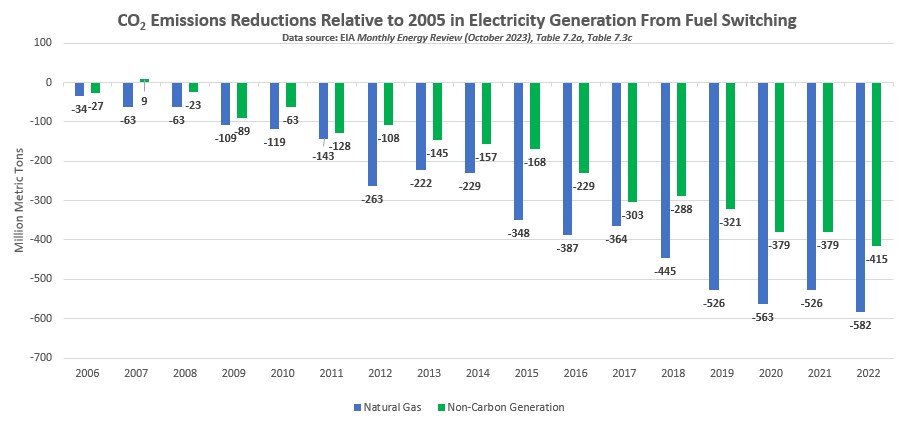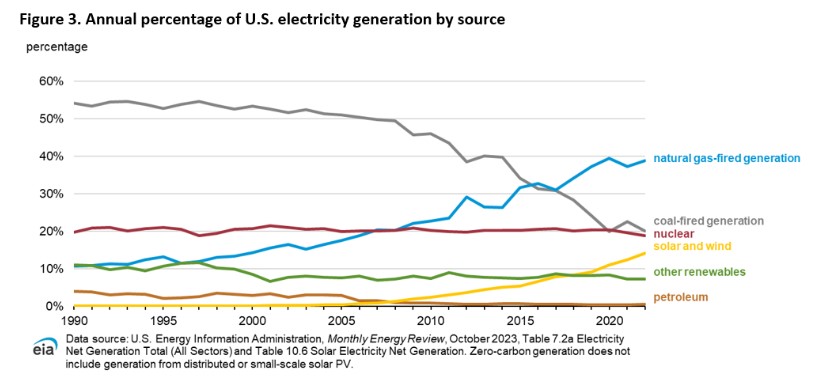With COP28 Underway, Natural Gas Still Leading America’s Success in Reducing CO2
Mark Green
Posted December 5, 2023
Natural gas continues lead the way in reducing U.S. carbon dioxide (CO2) emissions from power generation, according to the federal Energy Information Administration’s (EIA) new report on energy-related CO2 emissions – a timely report, indeed, on “Energy Day” at the COP28 climate conference in United Arab Emirates.
The role of natural gas in reducing CO2 emissions over the past 16 years should give pause to those at COP28 and elsewhere who believe that natural gas (and oil) must be phased out to make climate progress. In the U.S., switching to natural gas to fuel electricity generation is responsible for more than 60% of CO2 emissions reductions in the power sector since 2005.

Overall, U.S. CO2 emissions ticked up slightly in 2022, EIA said, as the nation continued to recover from the economic effects of the pandemic, with most of the CO2 rise resulting from increased air travel. Other points from the government report:
- The 1% increase in U.S. CO2 emissions in 2022 was much slower than the 7% increase in 2021, EIA said. In 2022, the U.S. produced 4% less energy-related CO2 than it did just before the pandemic in 2019.
- Changes in electricity generation sources decreased the carbon intensity of electricity by 4% last year – from 392 metric tons of CO2 per gigawatthour (GWh) in 2021 to 376 metric tons per GWh in 2022.
- U.S. coal-related CO2 emissions decreased by 7% last year from 2021, as a result of a near 8% decrease in coal-fired power generation. Cleaner-burning natural gas helped fill the gap.
- Between January 2021 and December 2022, American workers installed more than 17,000 megawatts of new and highly efficient natural gas-fueled generating capacity.
- Natural gas continued to be the top fuel for generating electricity in 2022, representing nearly 40% of U.S. generation (chart):

The undeniable point is the importance of natural gas in reducing U.S. CO2 emissions.
Since 2000, the U.S. leads the world in reducing CO2 emissions, during which time America became the world leader in natural gas and oil production.
Other energy sources are important, too, but remember that natural gas is needed to maintain grid reliability as more intermittent resources are added to the grid.
Another point: Other nations have the opportunity to replicate our template for emissions reductions by importing U.S. liquefied natural gas.
Remarkably, America’s natural gas and oil industry is producing record volumes of energy while reducing methane emissions, which are down 16% since 1990 – even though economic activity and energy use has increased over the same period.
Industry-led initiatives such as The Environmental Partnership are helping make the development, transportation, and storage of natural gas and oil cleaner. For example, the Partnership’s programs include the timely detection and repair of leaks and flare management. Participants reported a 2.4% reduction in flare intensity and a 14% reduction in total flare volumes in 2022 over 2021. That’s while U.S. natural gas and oil production increased 4% and 5.6%, respectively.
As the COP28 climate conference continues in Dubai, the natural gas story is one that should not go unnoticed.
About The Author
Mark Green joined API after a career in newspaper journalism, including 16 years as national editorial writer for The Oklahoman in the paper’s Washington bureau. Previously, Mark was a reporter, copy editor and sports editor at an assortment of newspapers. He earned his journalism degree from the University of Oklahoma and master’s in journalism and public affairs from American University. He and his wife Pamela have two grown children and six grandchildren.


